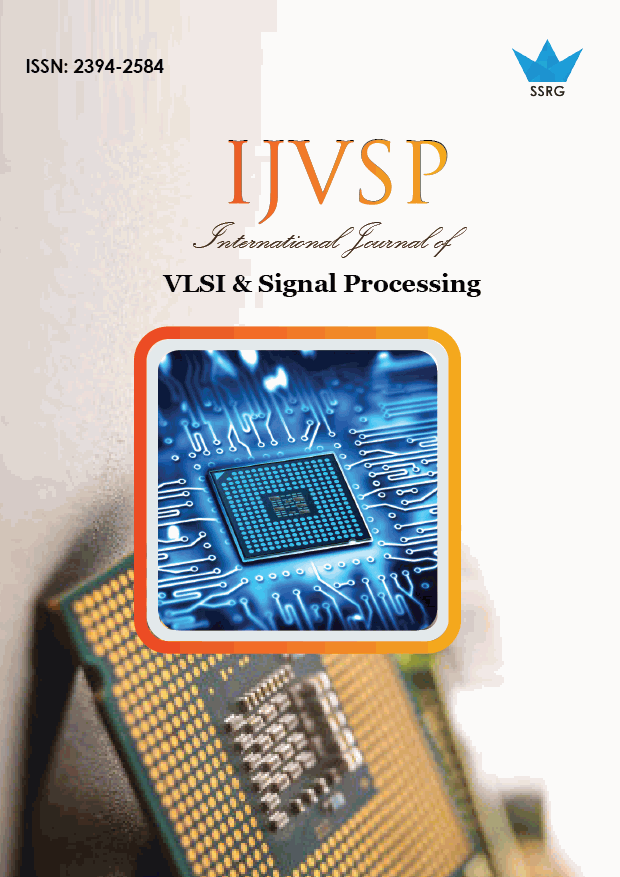Signal Processing in Mobile Communication using DSP and Multi media Communication via GSM

| International Journal of VLSI & Signal Processing |
| © 2014 by SSRG - IJVSP Journal |
| Volume 1 Issue 1 |
| Year of Publication : 2014 |
| Authors : M.Sivakami and Dr.A.Palanisamy |
How to Cite?
M.Sivakami and Dr.A.Palanisamy, "Signal Processing in Mobile Communication using DSP and Multi media Communication via GSM," SSRG International Journal of VLSI & Signal Processing, vol. 1, no. 1, pp. 7-9, 2014. Crossref, https://doi.org/10.14445/23942584/IJVSP-V1I1P103
Abstract:
This paper discuss about how data can be communicated between the mobile using digital signal processing and how literally it will detect the multi input and multi output control mechanism. And it will also speaks about the communication of multimedia system through the GSM systems. It will be communicated via many standards and the propagations is based on the various rules and regulations. The signal processing will challenges the intelligent video adaptation for the mobile devices. And the distributed coding for the mobile video applications and the signal processing for the video transmission over the multi input and multi output control. The Wireless infrastructure that supports the third generation computer for the mobile communications consist of many different standards. The energy constrained video encoding the Wireless commmunication
Keywords:
Mobile Digital Video, Digital Signal Processing, Multi Input and Multi Output
References:
[1] G. Fettweis, S. Wang, “Strategies in a cost-effective implementation of the PDC half-ratecodec for wireless communications,” IEEE 46th.
[2] Meyr, H., Moeneclaey, M., Fechtel, S. A., "Digital communication receivers: synchronization, channel estimation and signal processing," John Wiley&Sons, ISBN 0-471-50275-8.
[3] Gatherer, E. Auslander, editors, “The application of programmable DSPs in Mobile Communication”, Ed.Wiley, (2002).
[4] Y. Okumura, T. Ohya, Y. Miki, T. Miki, “A study of DSP circuits applied to speech codec for digital mobile communications,” Proc. of the Fall Meeting of the IEICE, B-294, p.2-294(1993).
[5] Oppenheim, A. V., Schafer, R. W., "Discrete-time signal processing," Prentice-Hall, ISBN 0-13-754920-2.
[6] Berkeley Design Technology, Inc., “The Evolution of DSP Processors”, World Wide Web,http://www.bdti.com/articles/evolution.pdf, Nov. 2006.
[7] Berkeley Design Technology, Inc., “Choosing a Processor: Benchmark and Beyond”, World Wide Web, http://www.bdti.com/articles/20060301_TIDC_Choosing.pdf, Nov. 2006.
[8] Haykin, S., "Adaptive filter theory," Prentice-Hall, ISBN 0-13-090126-1.
[9] Gene Frantz, “Digital Signal Processor Trends”, Proceedings of the IEEE Micro , Vol. 20, No. 6, 2000, pp. 52-59.
[10] TexasInstruments,TMS320VC5510/5510A, Fixed-Point Digital Signal Processors, Data Manual, Dallas, TX, July 2006.
[11] Texas Instruments, TMS320C62X/C67X, Programmers’ Guide, Dallas, TX, May 1999.
[12] Texas Instruments, TMS320C6000, Peripherals, Reference Guide, Dallas, TX, March 2001.
[13] Texas Instruments, Inc TMS320C55x, Technical Overview, Dallas, TX, Feb. 2000.
[14] Texas Instruments, TMS320C6713B, Floating-Point Digital Signal Processors, Data Sheet, Dallas, TX, June 2006.
[15] Texas Instruments, TMS320C55x DSP Peripherals Overview Reference Guide, Dallas, TX, April 2006.
[16] Steven W. Smith, The Scientist and Engineer’s Guide to Digital Signal Processing, Second Edition, California Technical Publishing, 1999
[17] University of Rochester, “DSP Architectures: Past, Present and Future”, WorldWideWeb,http://www.ece.rochester.edu/research/wcng/papers/CAN_r1.pdf, Nov. 2006.
[18] Van Trees, H. L., "Detection, estimation and modulation theory," John Wiley&Sons, ISBN 0-471-09517-6.
[19] Gerhard Fettweis, “DSP Cores for MobileCommunications: Where are we going?”.

 10.14445/23942584/IJVSP-V1I1P103
10.14445/23942584/IJVSP-V1I1P103